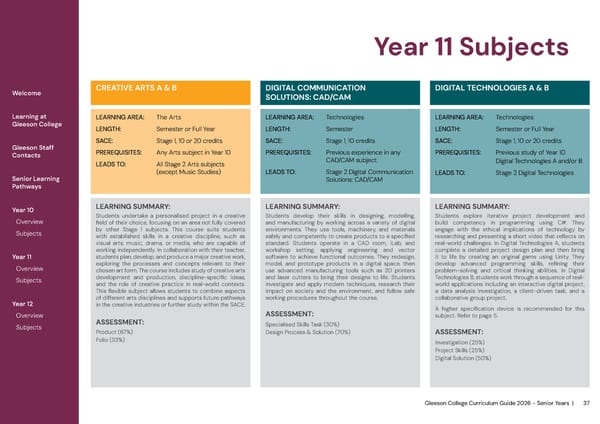Gleeson College Curriculum Guide 2026 - Senior Years | 37 Year 11 Subjects Welcome Learning at Gleeson College Gleeson Staff Contacts Senior Learning Pathways Year 10 Overview Subjects Year 11 Overview Subjects Year 12 Overview Subjects LEARNING SUMMARY: Students undertake a personalised project in a creative field of their choice, focusing on an area not fully covered by other Stage 1 subjects. This course suits students with established skills in a creative discipline, such as visual arts, music, drama, or media, who are capable of working independently. In collaboration with their teacher, students plan, develop, and produce a major creative work, exploring the processes and concepts relevant to their chosen art form. The course includes study of creative arts development and production, discipline-specific ideas, and the role of creative practice in real-world contexts. This flexible subject allows students to combine aspects of different arts disciplines and supports future pathways in the creative industries or further study within the SACE. ASSESSMENT: Product (67%) Folio (33%) CREATIVE ARTS A & B LEARNING AREA: The Arts LENGTH: Semester or Full Year SACE: Stage 1, 10 or 20 credits PREREQUISITES: Any Arts subject in Year 10 LEADS TO: All Stage 2 Arts subjects (except Music Studies) DIGITAL COMMUNICATION SOLUTIONS: CAD/CAM LEARNING AREA: Technologies LENGTH: Semester SACE: Stage 1, 10 credits PREREQUISITES: Previous experience in any CAD/CAM subject LEADS TO: Stage 2 Digital Communication Solutions: CAD/CAM LEARNING SUMMARY: Students develop their skills in designing, modelling, and manufacturing by working across a variety of digital environments. They use tools, machinery, and materials safely and competently to create products to a specified standard. Students operate in a CAD room, iLab, and workshop setting, applying engineering and vector software to achieve functional outcomes. They redesign, model, and prototype products in a digital space, then use advanced manufacturing tools such as 3D printers and laser cutters to bring their designs to life. Students investigate and apply modern techniques, research their impact on society and the environment, and follow safe working procedures throughout the course. ASSESSMENT: Specialised Skills Task (30%) Design Process & Solution (70%) DIGITAL TECHNOLOGIES A & B LEARNING AREA: Technologies LENGTH: Semester or Full Year SACE: Stage 1, 10 or 20 credits PREREQUISITES: Previous study of Year 10 Digital Technologies A and/or B LEADS TO: Stage 2 Digital Technologies LEARNING SUMMARY: Students explore iterative project development and build competency in programming using C#. They engage with the ethical implications of technology by researching and presenting a short video that reflects on real-world challenges. In Digital Technologies A, students complete a detailed project design plan and then bring it to life by creating an original game using Unity. They develop advanced programming skills, refining their problem-solving and critical thinking abilities. In Digital Technologies B, students work through a sequence of real- world applications including an interactive digital project, a data analysis investigation, a client-driven task, and a collaborative group project. A higher specification device is recommended for this subject. Refer to page 5. ASSESSMENT: Investigation (25%) Project Skills (25%) Digital Solution (50%)
 2026 Gleeson College Senior Years Curriculum Guide 2026 Page 36 Page 38
2026 Gleeson College Senior Years Curriculum Guide 2026 Page 36 Page 38